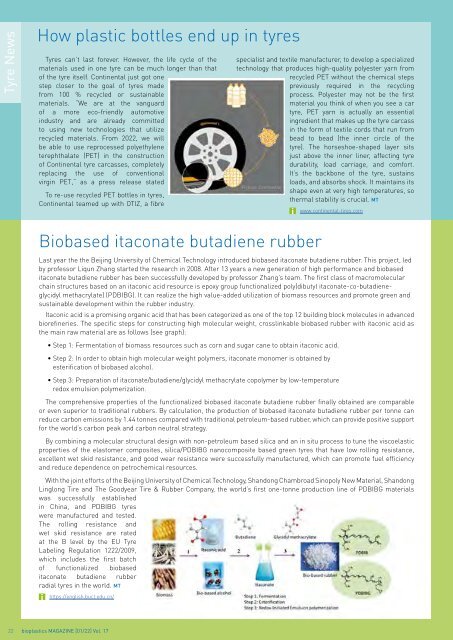issue 01/2022
Highlights: Automotive Foam Basics: Biodegradation
Highlights:
Automotive
Foam
Basics: Biodegradation
Create successful ePaper yourself
Turn your PDF publications into a flip-book with our unique Google optimized e-Paper software.
Tyre News<br />
How plastic bottles end up in tyres<br />
Tyres can’t last forever. However, the life cycle of the<br />
materials used in one tyre can be much longer than that<br />
of the tyre itself. Continental just got one<br />
step closer to the goal of tyres made<br />
from 100 % recycled or sustainable<br />
materials. “We are at the vanguard<br />
of a more eco-friendly automotive<br />
industry and are already committed<br />
to using new technologies that utilize<br />
recycled materials. From <strong>2022</strong>, we will<br />
be able to use reprocessed polyethylene<br />
terephthalate (PET) in the construction<br />
of Continental tyre carcasses, completely<br />
replacing the use of conventional<br />
virgin PET,“ as a press release stated<br />
To re-use recycled PET bottles in tyres,<br />
Continental teamed up with OTIZ, a fibre<br />
specialist and textile manufacturer, to develop a specialized<br />
technology that produces high-quality polyester yarn from<br />
recycled PET without the chemical steps<br />
previously required in the recycling<br />
process. Polyester may not be the first<br />
material you think of when you see a car<br />
tyre, PET yarn is actually an essential<br />
ingredient that makes up the tyre carcass<br />
in the form of textile cords that run from<br />
bead to bead (the inner circle of the<br />
tyre). The horseshoe-shaped layer sits<br />
just above the inner liner, affecting tyre<br />
durability, load carriage, and comfort.<br />
It’s the backbone of the tyre, sustains<br />
loads, and absorbs shock. It maintains its<br />
Picture: Continental<br />
shape even at very high temperatures, so<br />
thermal stability is crucial. MT<br />
www.continental-tires.com<br />
Biobased itaconate butadiene rubber<br />
Last year the the Beijing University of Chemical Technology introduced biobased itaconate butadiene rubber. This project, led<br />
by professor Liqun Zhang started the research in 2008. After 13 years a new generation of high performance and biobased<br />
itaconate butadiene rubber has been successfully developed by professor Zhang’s team. The first class of macromolecular<br />
chain structures based on an itaconic acid resource is epoxy group functionalized poly(dibutyl itaconate-co-butadieneglycidyl<br />
methacrylate) (PDBIBG). It can realize the high value-added utilization of biomass resources and promote green and<br />
sustainable development within the rubber industry.<br />
Itaconic acid is a promising organic acid that has been categorized as one of the top 12 building block molecules in advanced<br />
biorefineries. The specific steps for constructing high molecular weight, crosslinkable biobased rubber with itaconic acid as<br />
the main raw material are as follows (see graph):<br />
• Step 1: Fermentation of biomass resources such as corn and sugar cane to obtain itaconic acid.<br />
• Step 2: In order to obtain high molecular weight polymers, itaconate monomer is obtained by<br />
esterification of biobased alcohol.<br />
• Step 3: Preparation of itaconate/butadiene/glycidyl methacrylate copolymer by low-temperature<br />
redox emulsion polymerization.<br />
The comprehensive properties of the functionalized biobased itaconate butadiene rubber finally obtained are comparable<br />
or even superior to traditional rubbers. By calculation, the production of biobased itaconate butadiene rubber per tonne can<br />
reduce carbon emissions by 1.44 tonnes compared with traditional petroleum-based rubber, which can provide positive support<br />
for the world’s carbon peak and carbon neutral strategy.<br />
By combining a molecular structural design with non-petroleum based silica and an in situ process to tune the viscoelastic<br />
properties of the elastomer composites, silica/PDBIBG nanocomposite based green tyres that have low rolling resistance,<br />
excellent wet skid resistance, and good wear resistance were successfully manufactured, which can promote fuel efficiency<br />
and reduce dependence on petrochemical resources.<br />
With the joint efforts of the Beijing University of Chemical Technology, Shandong Chambroad Sinopoly New Material, Shandong<br />
Linglong Tire and The Goodyear Tire & Rubber Company, the world’s first one-tonne production line of PDBIBG materials<br />
was successfully established<br />
in China, and PDBIBG tyres<br />
were manufactured and tested.<br />
The rolling resistance and<br />
wet skid resistance are rated<br />
at the B level by the EU Tyre<br />
Labeling Regulation 1222/2009,<br />
which includes the first batch<br />
of functionalized biobased<br />
itaconate butadiene rubber<br />
radial tyres in the world. MT<br />
https://english.buct.edu.cn/<br />
22 bioplastics MAGAZINE [<strong>01</strong>/22] Vol. 17

















